Journal of Southern Medical University ›› 2024, Vol. 44 ›› Issue (12): 2335-2346.doi: 10.12122/j.issn.1673-4254.2024.12.09
Minzhu NIU1( ), Lixia YIN2, Ting DUAN3, Ju HUANG4, Jing LI2, Zhijun GENG4, Jianguo HU2, Chuanwang SONG1(
), Lixia YIN2, Ting DUAN3, Ju HUANG4, Jing LI2, Zhijun GENG4, Jianguo HU2, Chuanwang SONG1( )
)
Received:2024-09-27
Online:2024-12-20
Published:2024-12-26
Contact:
Chuanwang SONG
E-mail:nmz8033@163.com;bbmcscw@foxmail.com
Supported by:Minzhu NIU, Lixia YIN, Ting DUAN, Ju HUANG, Jing LI, Zhijun GENG, Jianguo HU, Chuanwang SONG. Asperosaponin VI alleviates TNBS-induced Crohn's disease-like colitis in mice by reducing intestinal epithelial cell apoptosis via inhibiting the PI3K/AKT/NF-κB signaling pathway[J]. Journal of Southern Medical University, 2024, 44(12): 2335-2346.
Add to citation manager EndNote|Ris|BibTeX
URL: https://www.j-smu.com/EN/10.12122/j.issn.1673-4254.2024.12.09
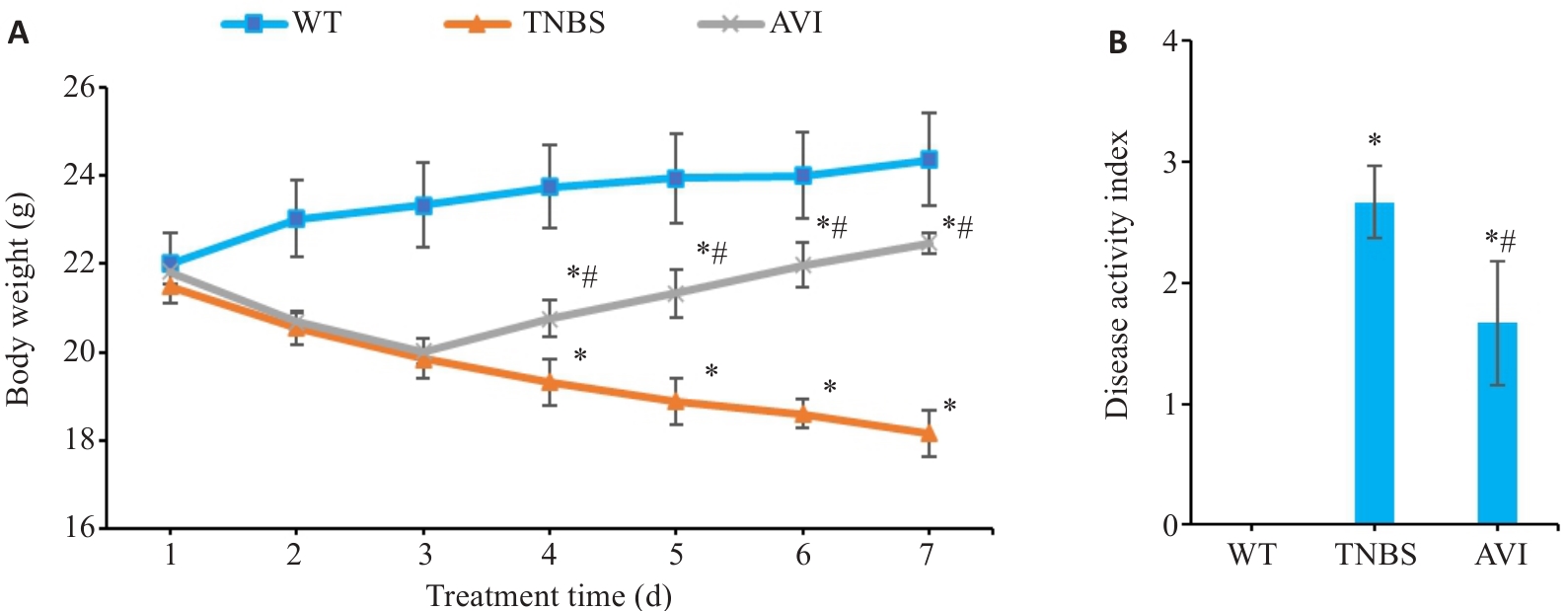
Fig.1 Effect of AVI intervention on body weight and disease activity in mice with TNBS-induced CD-like colitis. A: Changes of body weight. B: Changes of DAI scores. WT: Wild type group; TNBS: TNBS-induced model group; AVI: AVI treatment group. *P<0.05 vs WT group. #P<0.05 vs TNBS group.
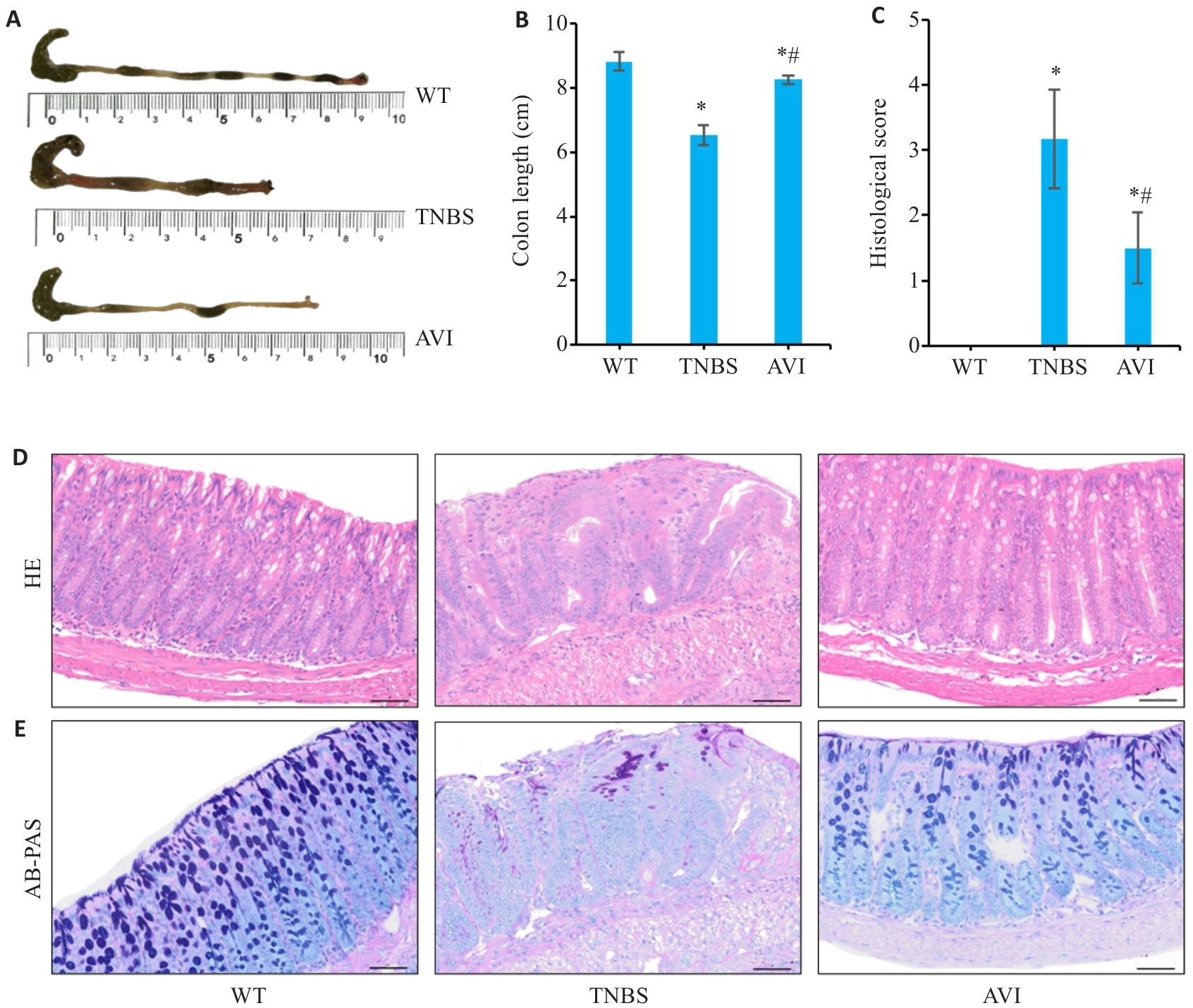
Fig.2 Effect of AVI on intestinal inflammation in the mouse models. A, B: Comparison of colon lengths among the groups. C: Histopathological score of the colon. D: HE staining of colon tissue in different groups. E: AB-PAS staining of colon tissue in different groups. *P<0.05 vs WT group. #P<0.05 vs TNBS group. Scale bar=50 μm.

Fig.3 Effect of AVI on intestinal inflammatory factors in the mouse models. A, B: ELISA results of TNF‑α and IL-1β in the intestinal mucosa of the mice. C, D: TNF-α and IL-1β mRNA expression in the intestinal mucosa of the mice detected by RT-qPCR. *P<0.05 vs WT group. #P<0.05 vs TNBS group.
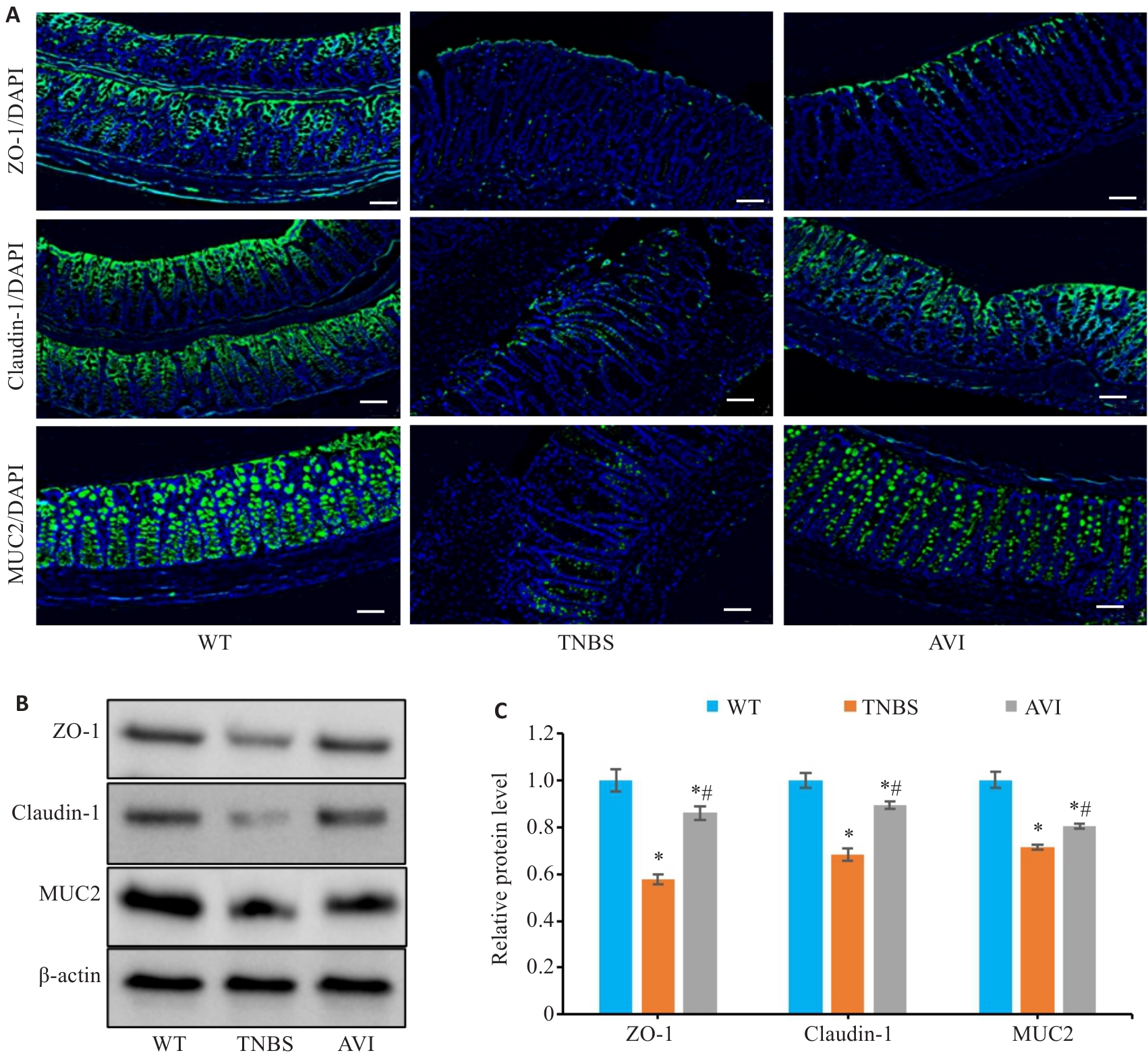
Fig.5 Effect of AVI on intestinal barrier function in mice with TNBS-induced colitis. A: Immunofluorescence staining for detecting ZO-1, claudin-1 and MUC2 in the mouse colon (Scale bar=50 μm). B, C: Relative expression levels of ZO-1, Claudin-1 and MUC2 proteins in intestinal mucosa detected by Western blotting. *P<0.05 vs WT group. #P<0.05 vs TNBS group.
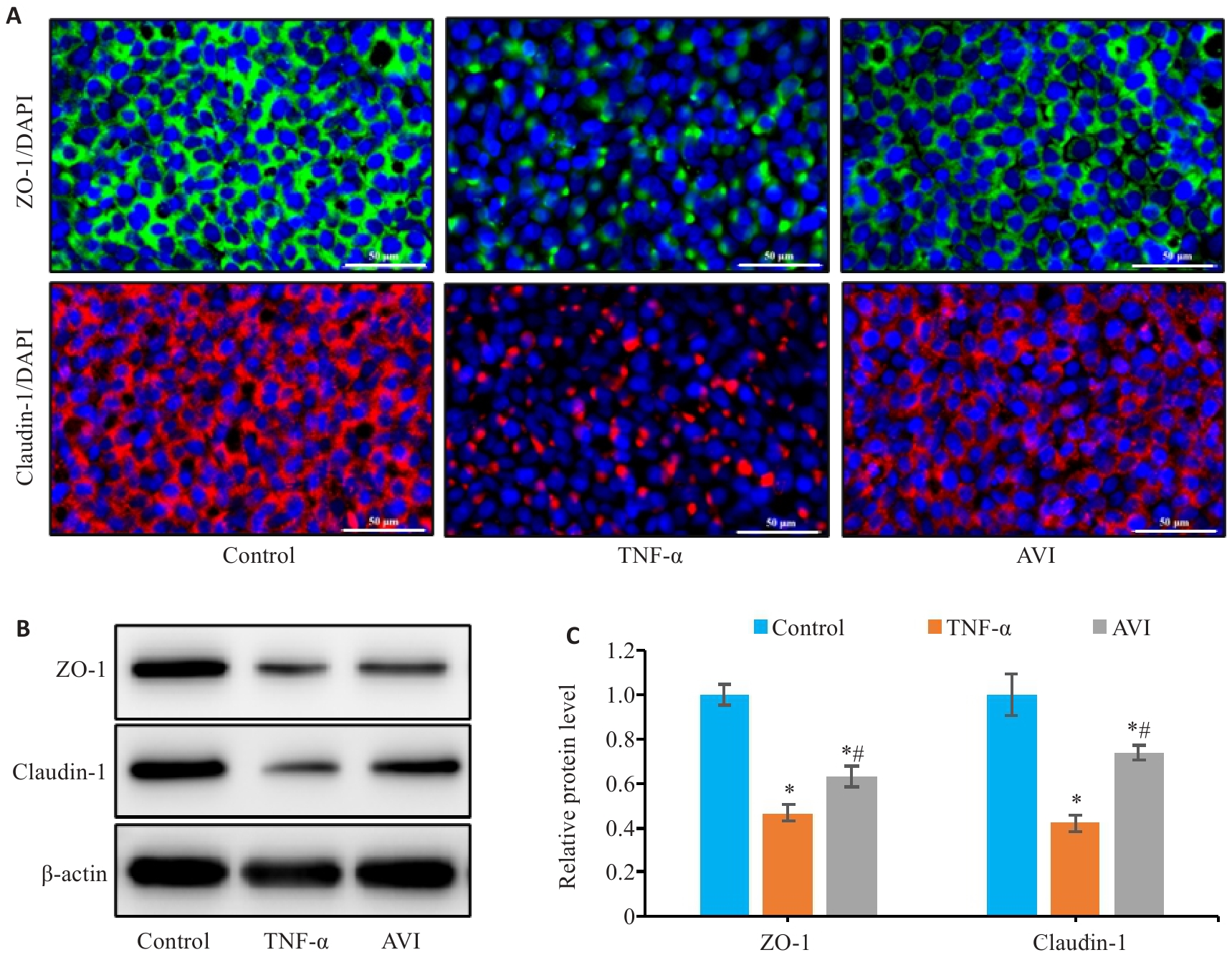
Fig.6 Effect of AVI on the barrier damage of Caco-2 cells induced by TNF-α. A: Immunofluorescence staining for detecting expressions of ZO-1 and claudin-1 in Caco-2 cells (Scale bar=50 μm). B, C: Relative expression levels of ZO-1 and claudin-1 proteins in Caco-2 cells detected by Western blotting. *P<0.05 vs Control group. #P<0.05 vs TNF-α group.
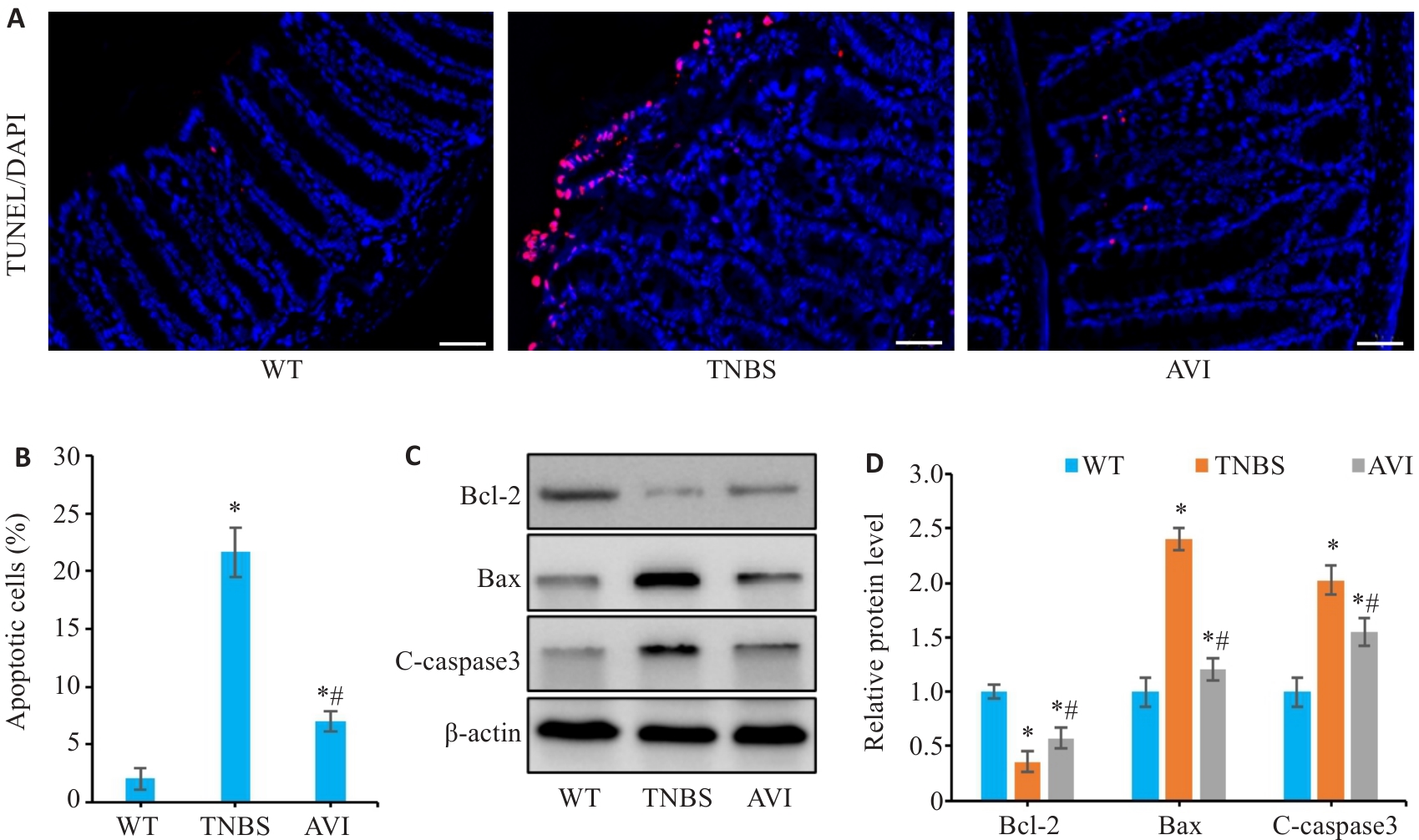
Fig.7 Effect of AVI on intestinal epithelial cell apoptosis in mice with TNBS-induced colitis. A: TUNEL staining of the colon tissue. B: Apoptosis rate of the intestinal epithelial cells (Scale bar=50 μm). C, D: Western blotting for detecting relative expression levels of Bcl-2, Bax and C-caspase3 in colonic mucosa. *P<0.05 vs WT group. #P<0.05 vs TNBS group.
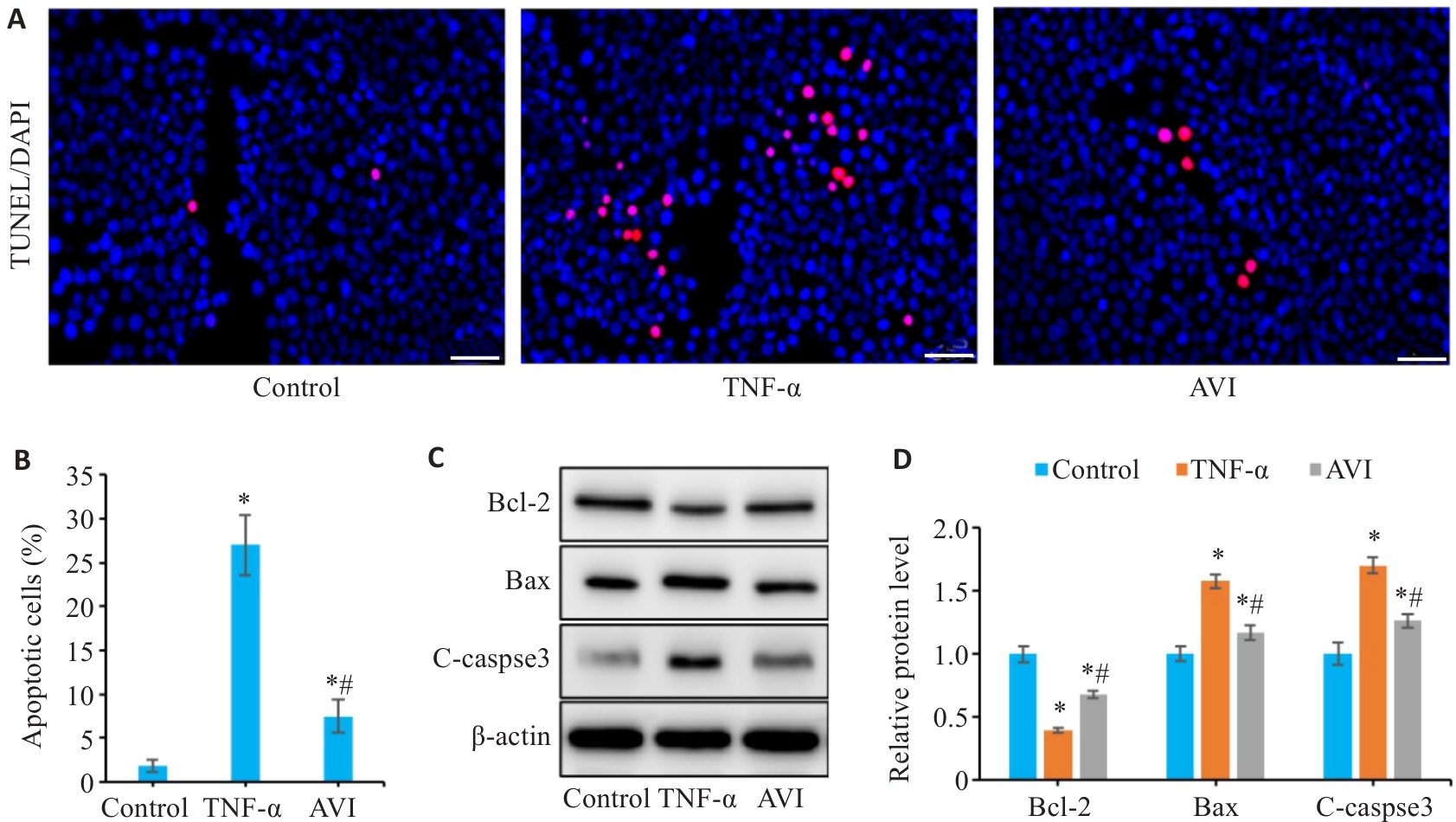
Fig.8 Effect of AVI on apoptosis in TNF-α-induced Caco-2 cells. A: TUNEL staining of Caco-2 cells (Scale bar=50 μm). B: Apoptosis rate of Caco-2 cells. C, D: Relative expression levels of Bcl-2, Bax and C-caspase-3 in Caco-2 cells detected by Western blotting.*P<0.05 vs Control group. #P<0.05 vs TNF-α group.
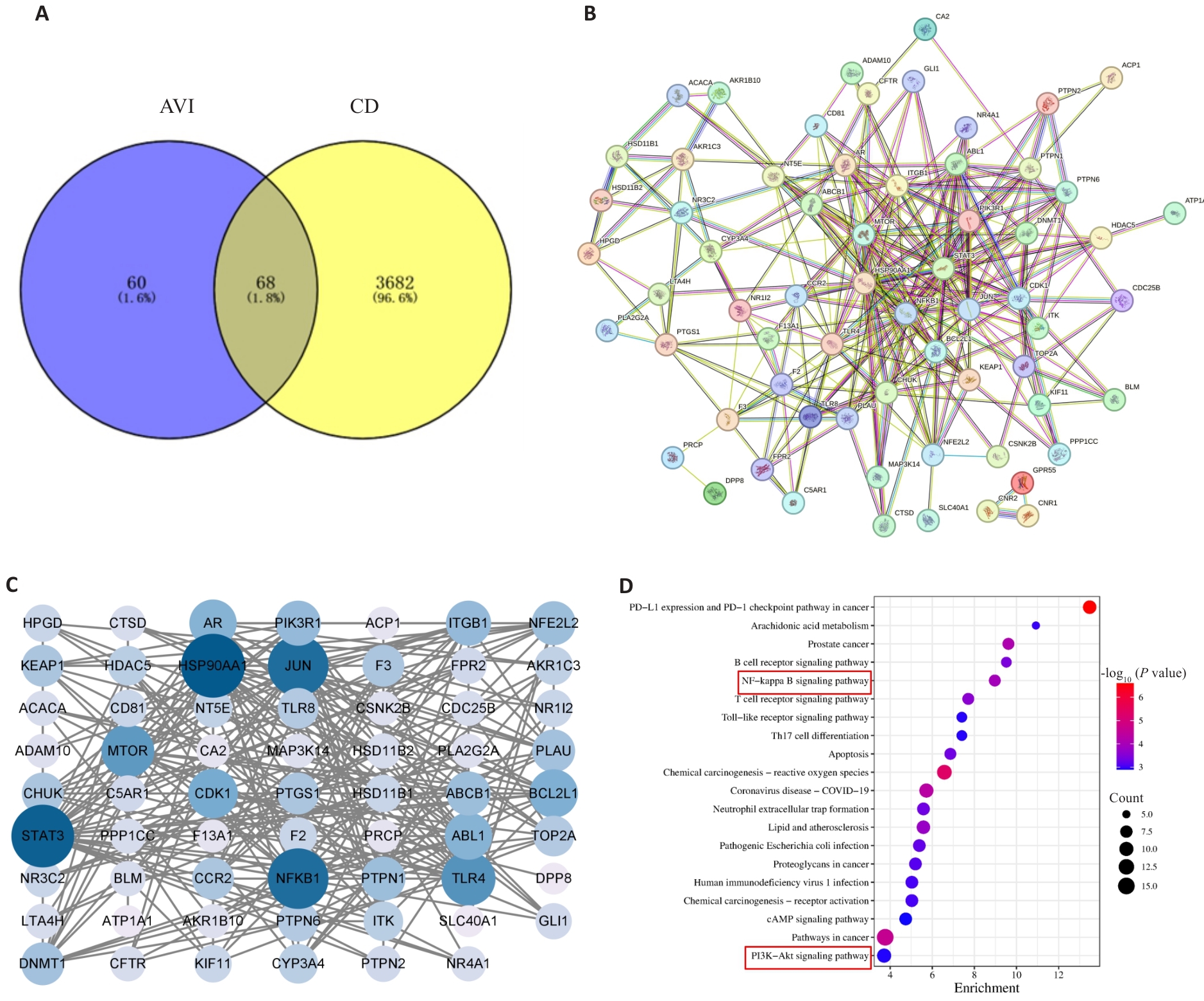
Fig.9 Network pharmacology analysis results. A: Venn diagram of the intersection between CD genes and AVI genes. B, C: PPI network diagram. D: Results of KEGG pathway enrichment analysis for the intersection genes between AVI and CD.
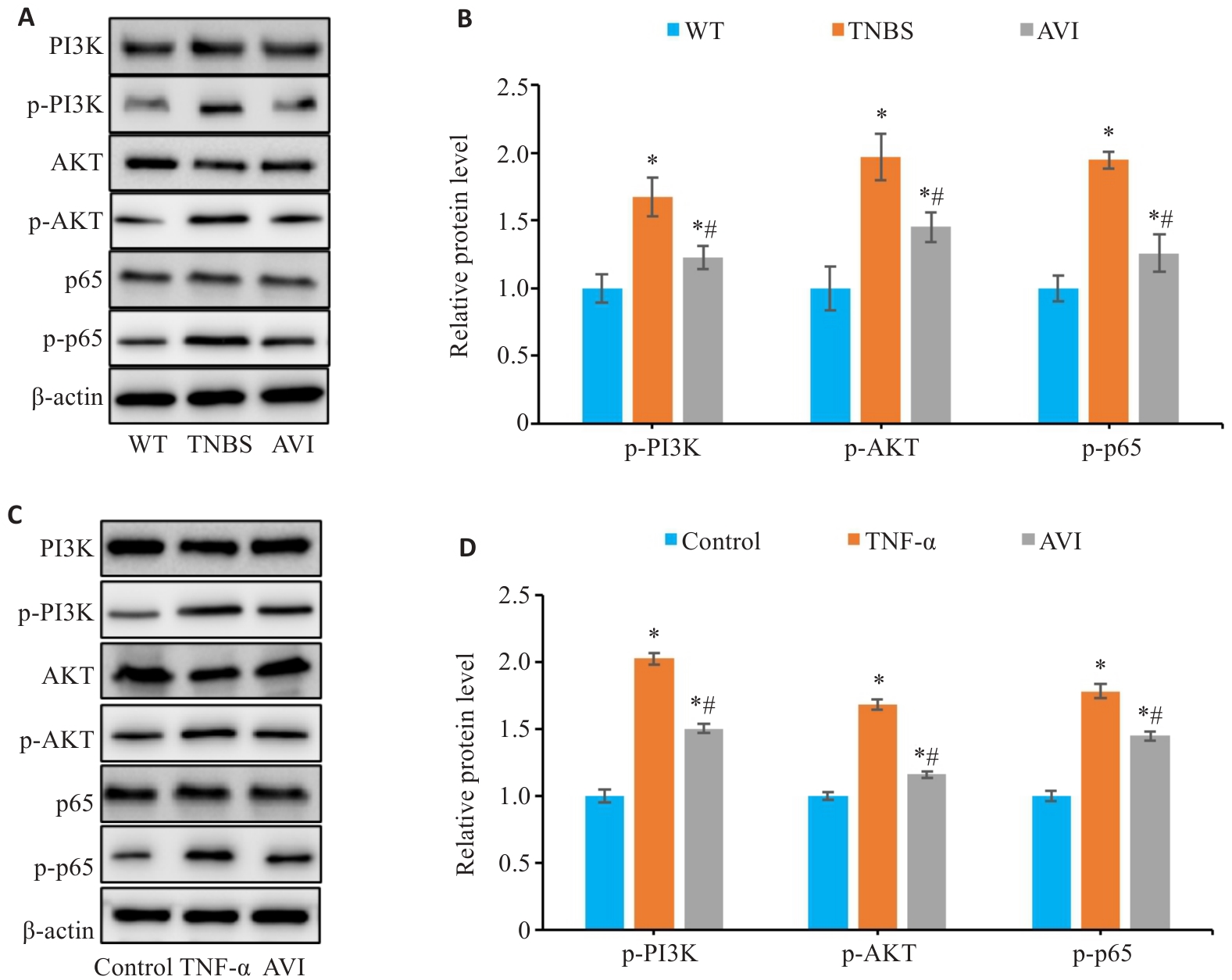
Fig.10 Effect of AVI on the PI3K/AKT/NF-κB pathway in the mouse models and in Caco-2 cells. A, B: Relative expression levels of PI3K, p-PI3K, AKT, p-AKT, p65 and p-p65 proteins in mouse colon tissue detected by Western blotting (*P<0.05 vs WT group; #P<0.05 vs TNBS group). C, D: Relative expression levels of PI3K, p-PI3K, AKT, p-AKT, p65 and p-p65 proteins in Caco-2 cells detected by Western blotting (*P<0.05 vs Control group. #P<0.05 vs TNF-α group).
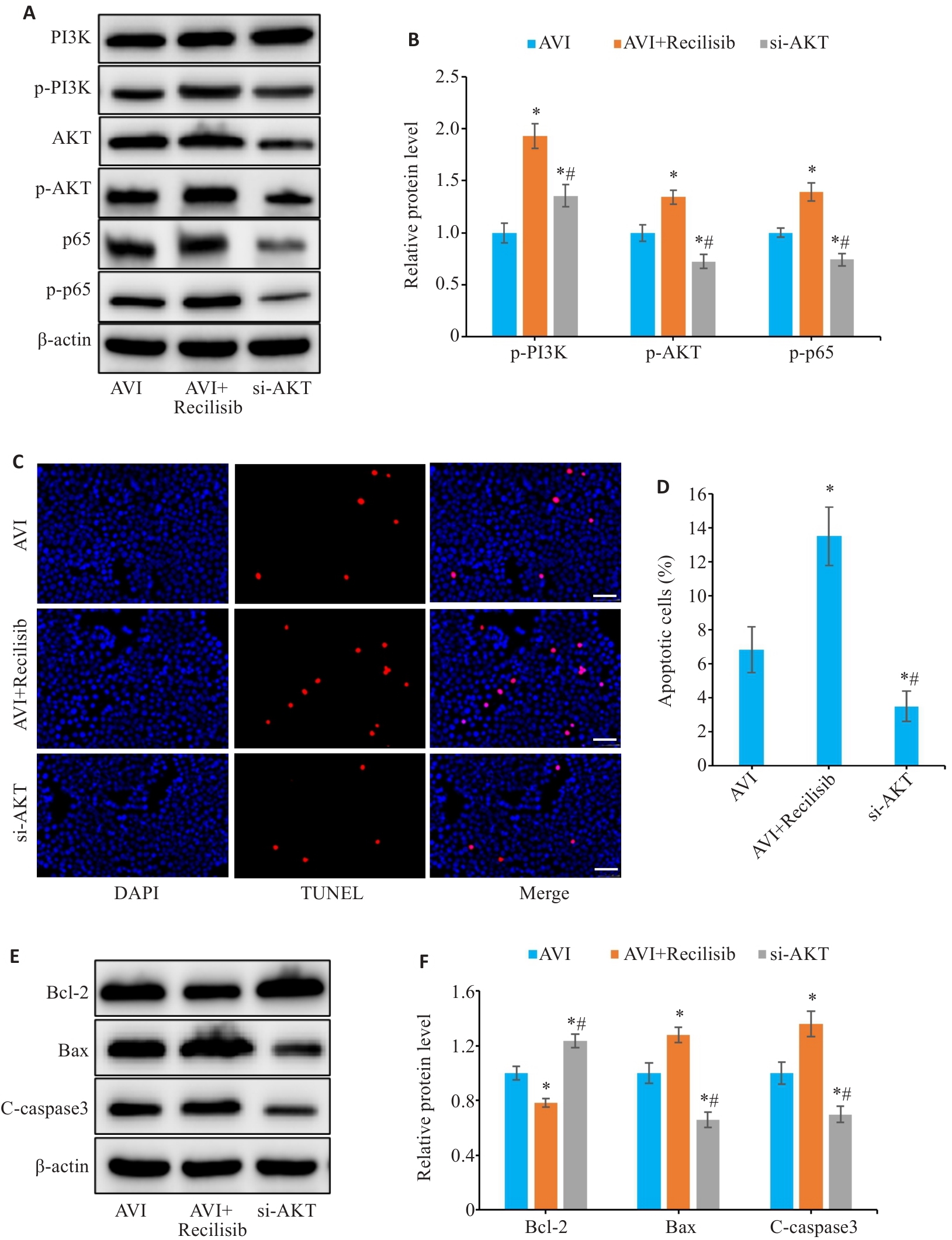
Fig.11 Effect of Recilisib and AKT1 siRNA on apoptosis of AVI-treated Caco-2 cells. A, B: Relative expression levels of PI3K, p-PI3K, AKT, p-AKT, p65 and p-p65 proteins detected by Western blotting. C: TUNEL staining of Caco-2 cells (Scale bar=50 μm). D: Apoptosis rate of Caco-2 cells. E, F: Relative expression levels of Bcl-2, Bax, and C-caspase3 proteins detected by Western blotting. *P<0.05 vs AVI group, #P<0.05 vs Recilisib group.
| 1 | Feuerstein JD, Cheifetz AS. Crohn disease: epidemiology, diagnosis, and management[J]. Mayo Clin Proc, 2017, 92(7): 1088-103. |
| 2 | Torres J, Mehandru S, Colombel JF, et al. Crohn's disease[J]. Lancet, 2017, 389(10080): 1741-55. |
| 3 | Keyashian K, Dehghan M, Sceats L, et al. Comparative incidence of inflammatory bowel disease in different age groups in the United States[J]. Inflamm Bowel Dis, 2019, 25(12): 1983-9. |
| 4 | Hutfless S, Jasper RA, Chen PH, et al. Burden of Crohn's disease in the United States Medicaid population, 2010-2019[J]. Clin Gastroenterol Hepatol, 2024, 22(5): 1087-97.e6. |
| 5 | Gomollón F, Dignass A, Annese V, et al. 3rd European evidence-based consensus on the diagnosis and management of Crohn's disease 2016: part 1: diagnosis and medical management[J]. J Crohns Colitis, 2017, 11(1): 3-25. |
| 6 | Lin K, Zheng WY, Guo MY, et al. The intestinal microbial metabolite acetyl l-carnitine improves gut inflammation and immune homeostasis via CADM2[J]. Biochim Biophys Acta Mol Basis Dis, 2024, 1870(4): 167089. |
| 7 | Vesci L, Tundo G, Soldi S, et al. A novel Lactobacillus brevis fermented with a vegetable substrate (AL0035) counteracts TNBS-induced colitis by modulating the gut microbiota composition and intestinal barrier[J]. Nutrients, 2024, 16(7): 937. |
| 8 | Kuo WT, Shen L, Zuo L, et al. Inflammation-induced occludin downregulation limits epithelial apoptosis by suppressing caspase-3 expression[J]. Gastroenterology, 2019, 157(5): 1323-37. |
| 9 | Petagna L, Antonelli A, Ganini C, et al. Pathophysiology of Crohn's disease inflammation and recurrence[J]. Biol Direct, 2020, 15(1): 23. |
| 10 | Zhang J, Cen L, Zhang XF, et al. MPST deficiency promotes intestinal epithelial cell apoptosis and aggravates inflammatory bowel disease via AKT[J]. Redox Biol, 2022, 56: 102469. |
| 11 | Torres J, Bonovas S, Doherty G, et al. ECCO guidelines on therapeutics in Crohn's disease: medical treatment[J]. J Crohns Colitis, 2020, 14(1): 4-22. |
| 12 | Yuan S, Wang Q, Li J, et al. Inflammatory bowel disease: an overview of Chinese herbal medicine formula-based treatment[J]. Chin Med, 2022, 17(1): 74. |
| 13 | Li CM, Tian JW, Li GS, et al. Asperosaponin VI protects cardiac myocytes from hypoxia-induced apoptosis via activation of the PI3K/Akt and CREB pathways[J]. Eur J Pharmacol, 2010, 649(1/2/3): 100-7. |
| 14 | Jiang X, Yi SN, Liu Q, et al. Asperosaponin VI ameliorates the CMS-induced depressive-like behaviors by inducing a neuroprotective microglial phenotype in hippocampus via PPAR‑γ pathway[J]. J Neuroinflammation, 2022, 19(1): 115. |
| 15 | Wei LL, Luo H, Jin Y, et al. Asperosaponin VI protects alcohol-induced hepatic steatosis and injury via regulating lipid metabolism and ER stress[J]. Phytomedicine, 2023, 121: 155080. |
| 16 | Xuan LL, Yang S, Ren LL, et al. Akebia saponin D attenuates allergic airway inflammation through AMPK activation[J]. J Nat Med, 2024, 78(2): 393-402. |
| 17 | Couto M, Andrade N, Magro F, et al. Taurocholate uptake by Caco-2 cells is inhibited by pro-inflammatory cytokines and butyrate[J]. Cytokine, 2023, 169: 156307. |
| 18 | Lu JJ, Shi XJ, Fu Q, et al. New mechanistic understanding of osteoclast differentiation and bone resorption mediated by P2X7 receptors and PI3K-Akt-GSK3β signaling[J]. Cell Mol Biol Lett, 2024, 29(1): 100. |
| 19 | Wang ZY, Chen JY, Babicheva A, et al. Endothelial upregulation of mechanosensitive channel Piezo1 in pulmonary hypertension[J]. Am J Physiol Cell Physiol, 2021, 321(6): C1010-C1027. |
| 20 | George B, Gui B, Raguraman R, et al. AKT1 transcriptomic landscape in breast cancer cells[J]. Cells, 2022, 11(15): 2290. |
| 21 | Dai YX, Lu QL, Li PY, et al. Xianglian Pill attenuates ulcerative colitis through TLR4/MyD88/NF‑κB signaling pathway[J]. J Ethnopharmacol, 2023, 300: 115690. |
| 22 | Li CL, Liu MG, Deng L, et al. Oxyberberine ameliorates TNBS-induced colitis in rats through suppressing inflammation and oxidative stress via Keap1/Nrf2/NF‑κB signaling pathways[J]. Phytomedicine, 2023, 116: 154899. |
| 23 | Dolinger M, Torres J, Vermeire S. Crohn's disease[J]. Lancet, 2024, 403(10432): 1177-91. |
| 24 | Zhang ZN, Zuo LG, Song X, et al. Arjunolic acid protects the intestinal epithelial barrier, ameliorating Crohn's disease-like colitis by restoring gut microbiota composition and inactivating TLR4 signalling[J]. Phytomedicine, 2024, 123: 155223. |
| 25 | 苏 超, 包 阔, 李佳威, 等. 人参皂苷衍生物AD-1通过抑制NLRP3炎症小体活化改善TNBS诱导的小鼠急性IBD[J]. 中国免疫学杂志, 2023, 39(11): 2305-10, 2317. |
| 26 | Yang XR, Liang J, Shu Y, et al. Asperosaponin VI facilitates the regeneration of skeletal muscle injury by suppressing GSK-3β-mediated cell apoptosis[J]. J Cell Biochem, 2024, 125(1): 115-26. |
| 27 | Jang DI, Lee AH, Shin HY, et al. The role of tumor necrosis factor alpha (TNF-α) in autoimmune disease and current TNF-α inhibitors in therapeutics[J]. Int J Mol Sci, 2021, 22(5): 2719. |
| 28 | Lenti MV, Santacroce G, Broglio G, et al. Recent advances in intestinal fibrosis[J]. Mol Aspects Med, 2024, 96: 101251. |
| 29 | Kim JT, Napier DL, Kim J, et al. Ketogenesis alleviates TNF‑α-induced apoptosis and inflammatory responses in intestinal cells[J]. Free Radic Biol Med, 2021, 172: 90-100. |
| 30 | Liu LQ, Yan MJ, Yang R, et al. Adiponectin attenuates lipopolysaccharide-induced apoptosis by regulating the Cx43/PI3K/AKT pathway[J]. Front Pharmacol, 2021, 12: 644225. |
| 31 | Lin CY, Tsai PH, Kandaswami CC, et al. Role of tissue transglutaminase 2 in the acquisition of a mesenchymal-like phenotype in highly invasive A431 tumor cells[J]. Mol Cancer, 2011, 10: 87. |
| 32 | Chalabi-Dchar M, Cassant-Sourdy S, Duluc C, et al. Loss of somatostatin receptor subtype 2 promotes growth of KRAS-induced pancreatic tumors in mice by activating PI3K signaling and overexpression of CXCL16[J]. Gastroenterology, 2015, 148(7): 1452-65. |
| 33 | Guo Q, Jin YZ, Chen XY, et al. NF‑κB in biology and targeted therapy: new insights and translational implications[J]. Signal Transduct Target Ther, 2024, 9(1): 53. |
| 34 | 刘兴隆, 张培旭, 熊珮宇, 等. 基于PI3K/Akt/NF-κB通路探讨人参败毒散、榆瑞灌肠液内外合治干预溃疡性结肠炎大鼠肠黏膜损伤的作用机制[J]. 中国实验方剂学杂志, 2023, 29(19): 42-51. |
| 35 | 李 多, 彭 昭, 张泽天, 等. 复方黄柏液通过PI3K/Akt/NF-κB信号通路逆转大鼠溃疡性结肠炎[J]. 中国老年学杂志, 2023, 43(9): 2241-4. |
| [1] | Shuo LIU, Jing LI, Xingwang WU. Swertiamarin ameliorates 2,4,6-trinitrobenzenesulfonic acid-induced colitis in mice by inhibiting intestinal epithelial cell apoptosis [J]. Journal of Southern Medical University, 2024, 44(8): 1545-1552. |
| [2] | Xiaofan CONG, Teng CHEN, Shuo LI, Yuanyuan WANG, Longyun ZHOU, Xiaolong LI, Pei ZHANG, Xiaojin SUN, Surong ZHAO. Dihydroartemisinin enhances sensitivity of nasopharyngeal carcinoma HNE1/DDP cells to cisplatin-induced apoptosis by promoting ROS production [J]. Journal of Southern Medical University, 2024, 44(8): 1553-1560. |
| [3] | Linyu XIAO, Ting DUAN, Yongsheng XIA, Yue CHEN, Yang SUN, Yibo XU, Lei XU, Xingzhou YAN, Jianguo HU. Linarin inhibits microglia activation-mediated neuroinflammation and neuronal apoptosis in mouse spinal cord injury by inhibiting the TLR4/NF-κB pathway [J]. Journal of Southern Medical University, 2024, 44(8): 1589-1598. |
| [4] | Mengdong ZHENG, Yan LIU, Jiaojiao LIU, Qiaozhen KANG, Ting WANG. Effect of deletion of protein 4.1R on proliferation, apoptosis and glycolysis of hepatocyte HL-7702 cells [J]. Journal of Southern Medical University, 2024, 44(7): 1355-1360. |
| [5] | Yuanguo WANG, Peng ZHANG. Ferroptosis suppressor genes are highly expressed in esophageal cancer to inhibit tumor cell ferroptosis [J]. Journal of Southern Medical University, 2024, 44(7): 1389-1396. |
| [6] | Zhijun REN, Jianxin DIAO, Yiting WANG. Xionggui Decoction alleviates heart failure in mice with myocardial infarction by inhibiting oxidative stress-induced cardiomyocyte apoptosis [J]. Journal of Southern Medical University, 2024, 44(7): 1416-1424. |
| [7] | Guiling CHEN, Xiaofeng LIAO, Pengtao SUN, Huan CEN, Shengchun SHU, Bijing LI, Jinhua LI. Solasonine promotes apoptosis of non-small cell lung cancer cells by regulating the Bcl-2/Bax/caspase-3 pathway [J]. Journal of Southern Medical University, 2024, 44(6): 1109-1116. |
| [8] | Lingjun LU, Xiaodi YANG, Huaping ZHANG, Yuan LIANG, Xiulan SHI, Xin ZHOU. Recombinant Schistosoma japonicum cystatin alleviates acute liver injury in mice by inhibiting endoplasmic reticulum stress, inflammation and hepatocyte apoptosis [J]. Journal of Southern Medical University, 2024, 44(6): 1126-1134. |
| [9] | Guoxin LIANG, Hongyue TANG, Chang GUO, Mingming ZHANG. MiR-224-5p overexpression inhibits oxidative stress by regulating the PI3K/Akt/FoxO1 axis to attenuate hypoxia/reoxygenation-induced cardiomyocyte injury [J]. Journal of Southern Medical University, 2024, 44(6): 1173-1181. |
| [10] | ZHANG Xiaoyan, WANG Xie, WANG Jie, SHAO Nan, CAI Biao, XIE Daojun. Huangpu Tongqiao Capsule improves cognitive impairment in rats with Wilson disease by inhibiting endoplasmic reticulum stress-mediated apoptosis pathway [J]. Journal of Southern Medical University, 2024, 44(3): 447-454. |
| [11] | CHEN Guodong, LUO Suxin. Colchicine alleviates myocardial ischemia-reperfusion injury in mice by activating AMPK [J]. Journal of Southern Medical University, 2024, 44(2): 226-235. |
| [12] | Xiuqi SUN, Jing CAI, Anbang ZHANG, Bo PANG, Chunyan CHENG, Qiqi CHA, Fei QUAN, Tao YE. Electroacupuncture pretreatment alleviates post-stroke spasticity in rats by inhibiting NF‑κB/NLRP3 signaling pathway-mediated inflammation and neuronal apoptosis [J]. Journal of Southern Medical University, 2024, 44(11): 2102-2109. |
| [13] | Jianguo QIU, Yitong QIU, Guorong LI, Linsheng ZHANG, Xue ZHENG, Yongjiang YAO, Xidan WANG, Haiyang HUANG, Fengmin ZHANG, Jiyan SU, Xuebao ZHENG, Xiaoqi HUANG. Huangqin Decoction alleviates ulcerative colitis in mice by reducing endoplasmic reticulum stress [J]. Journal of Southern Medical University, 2024, 44(11): 2172-2183. |
| [14] | Xuerou LIU, Yumei YANG, Wei LIU, Zhen ZHANG, Xingqi ZHOU, Wenyu XIE, Lin SHEN, Mengxiao ZHANG, Xian LI, Jialan ZANG, Shanshan LI. Euphorbia helioscopia inhibits proliferation, invasion, and migration and promotes apoptosis of non-small cell lung cancer cells [J]. Journal of Southern Medical University, 2024, 44(10): 1918-1925. |
| [15] | Yumei YANG, Xuerou LIU, Wei LIU, Xingqi ZHOU, Zhen ZHANG, Yan HU, Peipei LIU, Xian LI, Hao LIU, Shanshan LI. Aumolertinib combined with anlotinib inhibits proliferation of non-small cell lung cancer cells by down-regulating the PI3K/AKT pathway [J]. Journal of Southern Medical University, 2024, 44(10): 1965-1975. |
| Viewed | ||||||
|
Full text |
|
|||||
|
Abstract |
|
|||||